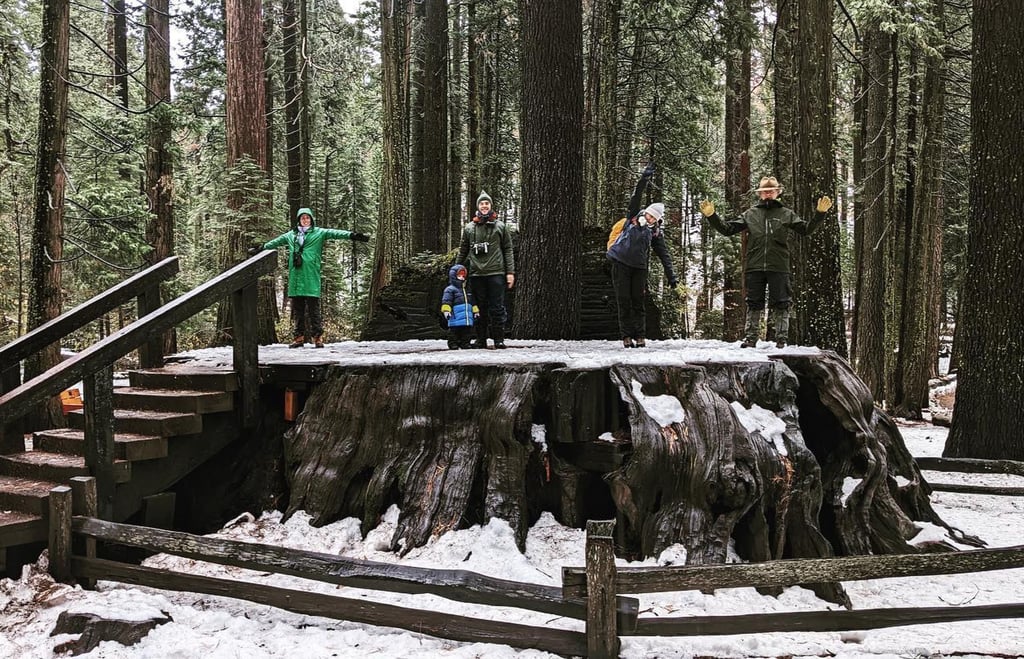There are the Siamese Twins: two sequoias that grew so close together they form a single mass for the first 15 metres (50 feet), before splaying towards the clouds.
There is Old Bachelor, an ancient gnarled specimen whose upper reaches are dead and may soon fall back to earth.
The Father of the Forest, a behemoth that fell centuries ago, is scratched with a thousand initials of Calaveras County teenagers.
The towering Empire State, thought to be the largest tree in the grove, stands like a monument to the mountains.
The park’s chief attraction, though, is the remains of a long dead, desecrated relative. An awe-inspiring tree that, through man’s idiocy, was turned into a dance floor.
Augustus Dowd was a bear hunter. One day in the spring of 1852, as most men in the mountains were looking for gold, Dowd shot a grizzly bear and followed its lumbering, bleeding body into the woods.
There, he stumbled upon a tree so magnificent it would change the way Americans treat the natural world forever.
Now known as the Discovery Tree, the giant sequoia Dowd saw was about 91 metres tall, and nine metres across its base.
“Surely, he mused, it must be a dream,” an article published in 1859 recounted, of Dowd’s discovery. “But no, the great realities were before him.”
Back at nearby Murphy’s Camp, where Dowd worked for the Union Water Company, no one believed his tall tale. He later told his acquaintances he had killed the biggest grizzly in the forest and needed help hauling it in, only to lure them to the tree.
Word of the natural wonder soon spread across California, America and the world, but within weeks, the majestic tree was felled, snuffed out of existence by greedy men who saw money in its bark.
It took five men 25 days to bring down the tree Dowd found. No saw was big enough for the job, so three-metre-long pump drills were used to repeatedly carve through its innards.
After about 1,000 years growing in that quiet grove in the Sierra foothills, it crashed to earth on June 27, 1853.
A massive cross section was hauled to San Francisco, where it was put on display on Bush Street for curious city folk to see at 50 cents a pop. It was then shipped around Cape Horn and exhibited in New York, but was destroyed by a fire before it could make it to another exhibit in Paris.

Back in Calaveras County, the base of the Discovery Tree was further humiliated.
On July 4 that year, 32 people had a dance party on the stump, as musicians and onlookers gathered around. A two-lane bowling alley and saloon were built on a fallen section of the trunk, and a hotel was built next door.
Even by 1850s standards, the abuse of nature alarmed some.
The New York Times called the tree the “greatest and most wonderful production of the vegetable kingdom ever known”, when reporting that it had been “sacrilegiously cut down”.
John Muir wrote an essay decrying the desecration of the Discovery Tree titled “The vandals then danced upon the stump!”
Another giant specimen in North Grove, known as the Mother of the Forest, was stripped of its bark a year later for profit (that tree’s bark was sent to London and exhibited at the Crystal Palace).
Skinned alive, its natural fire protection was gone, and it soon burned. The Mother of the Forest’s charred skeleton still stands today, a bleak reminder of man’s thoughtlessness.
In the years after Dowd’s discovery, criticism grew in the American press regarding treatment of the giant sequoias in Calaveras County.
The big trees had probably been known for centuries by the Miwok people and left unharmed, but the “discovery” of the trees by European settlers was close to a death sentence.
The felling and profiteering of the Discovery Tree was directly referenced in a speech given by California Senator John Conness in 1864, which led to passing of the Yosemite Grant, which would forever protect Yosemite Valley and eventually lead to the foundation of the national parks system.
The Calaveras Grove, and the 1,000 ancient trees within, would finally become a state park itself in 1931.
Finding the Discovery Tree stump today is a strange experience. Its sheer size is impressive, but the magnitude of sadness that surrounds it may be more dumbfounding.
After serving as a dance floor, the giant slab of wood was used as a wedding venue, concert stage, a newspaper print shop and even a school house, according to Carol Kramer’s excellent history book on the grove.
Today, schoolchildren gather around it and learn about the unique history of what is thought to be California’s oldest tourist attraction.
Climbing the 10 steps up onto the big tree’s ground zero, as thousands do each year for a photo opportunity, still feels a little disrespectful. But the sorrow there may be soothed by the rest of the trail, and the true majesty of the still living, and forever protected, giant sequoias on the North Grove Trail.
Each tree is quietly teeming with life. The thousands of roots, which only burrow a few feet deep into the soil, but spread out up to 45 metres from the trunk, pull nutrients and water up to the tree’s lofty crown.
Sunlight is turned to sugar in each tiny leaf, to nourish the tree. The spongy bark, sometimes up to two feet thick, is used for bird nests and tunnelled through by carpenter ants.
Clever red-breasted sapsuckers drill holes in the bark to trap insects in the sap and return later to feast on them.
There is a magic to the giant sequoia. The most massive tree on earth only grows here, on the western slope of the Sierra Nevada. Its bark somehow evolved to be fireproof, and no one is quite sure how and why they got so large when compared with other flora in the region.
Reaching out to touch a giant sequoia’s bark can feel like a religious experience. Muir once called them “the greatest of all living things”, and walking the grove, it is hard to disagree.







